Warcraft Retrospective 24: Paint This Continent Black
Last time, we saw Arthas lead the Scourge to the outskirts of Silvermoon, where he plans to raise Kel’Thuzad at the high elves’ sacred font of power, Comic Sans the Sunwell. Meanwhile, this was playing in the background.
The undead theme is an interesting departure from the others. Unlike the noble and triumphant human theme or the rousing and warlike orc theme, this one isn’t energetic. It’s eerie, haunting, and foreboding. Something foul is in the air, creeping on you and sapping your resolve — and the growls of the walking dead and the clanging of unholy mechanical contraptions will be the last sounds you hear before your life, too, is drained away.
The Fall of Silvermoon
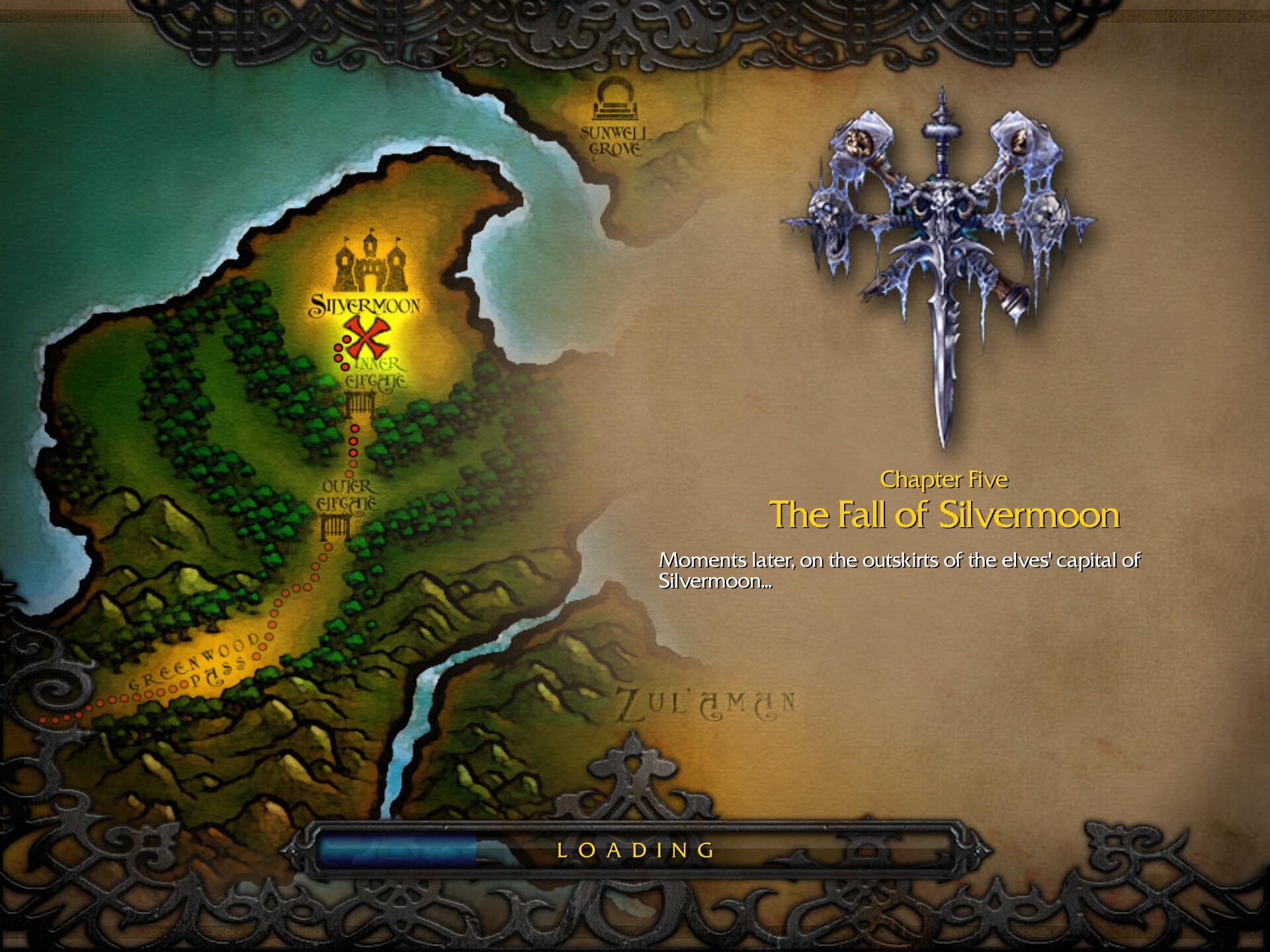
At the new undead base on the outskirts of Silvermoon, Tichondrius briefs Arthas on the Sunwell. There is animosity between the two, and Arthas suspects that the dreadlord suspects something about Kel’Thuzad’s ghost aiding him. Once again, exposition is worked into the dialogue without feeling too unnatural. Well… maybe.
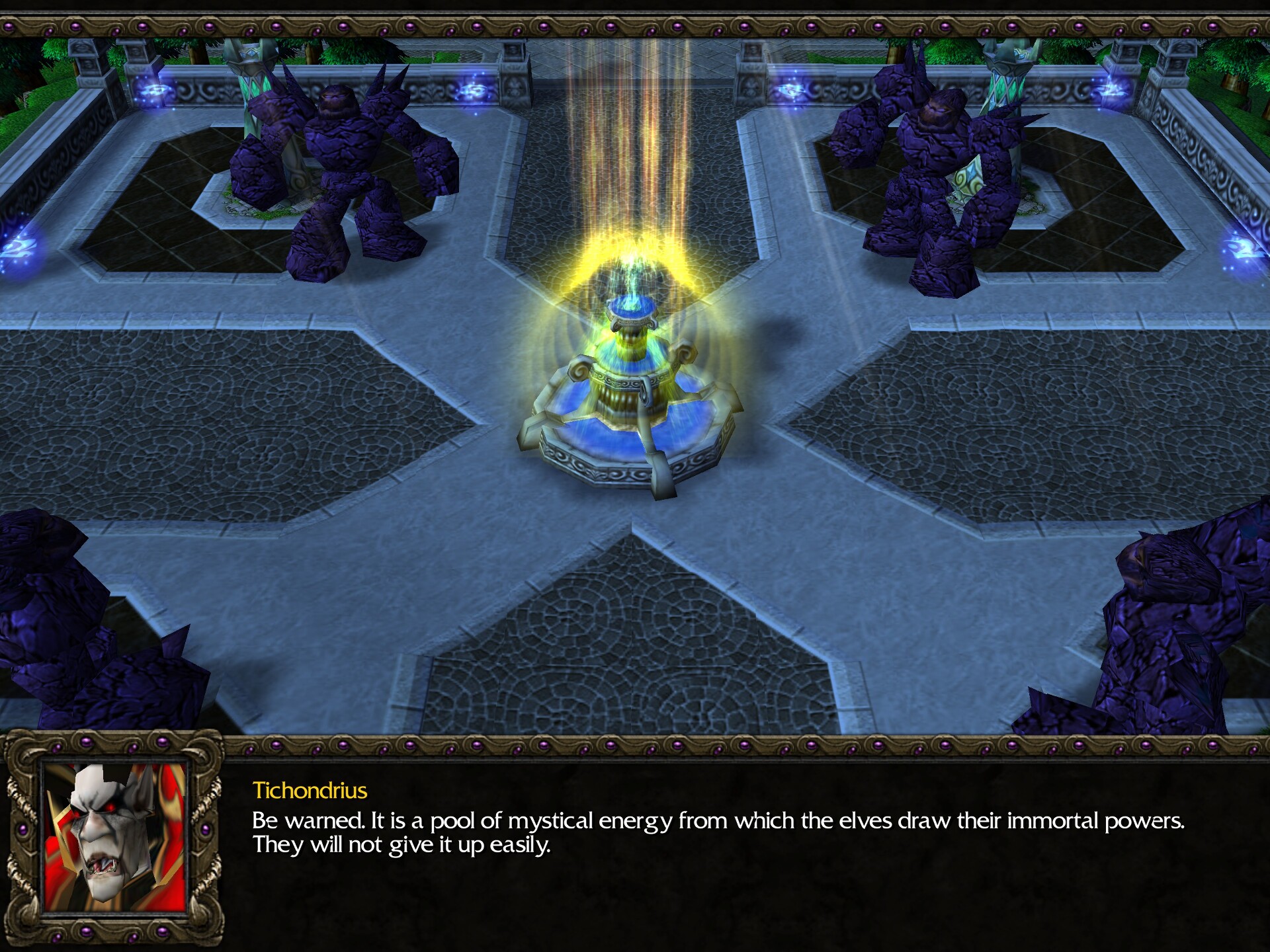
By Warcraft 3 standards, this map is pretty big, and you’re under pressure here, as your starting gold mine doesn’t have that much gold in it, and the only other ones are under enemy control. Sylvanas mounts an attack almost immediately.
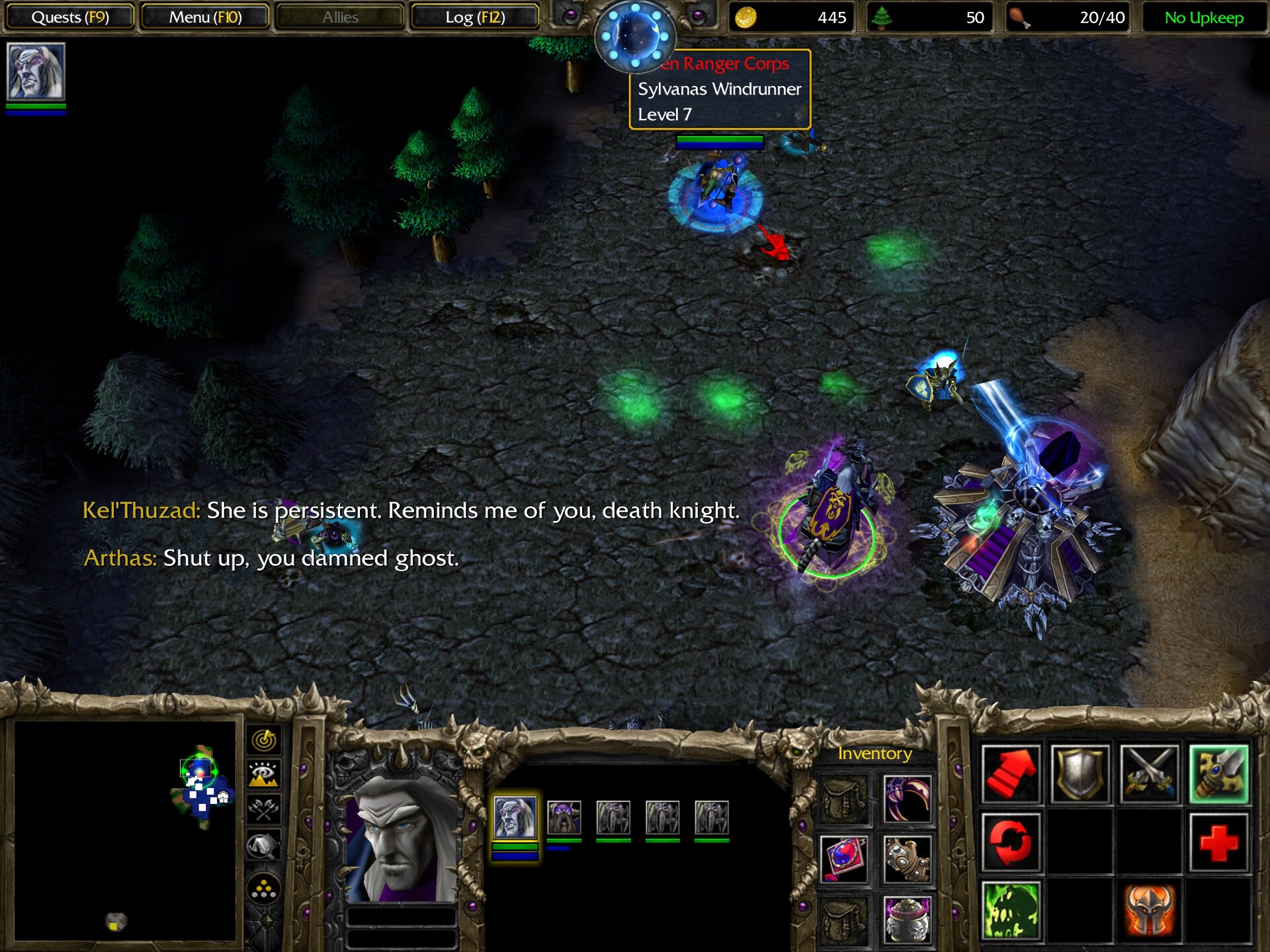
You’re on your own against Sylvanas’s base and the pretty sizable defenses of Silvermoon, but thankfully, the latter remain ignorant of you — for now. Soon, however, Sylvanas begins sending runners to Silvermoon, and if even one makes it through, the city will be alerted to your presence and begin mounting assaults on your base as well. Luckily, the runners have quite some distance to cover, and in a cutscene, you get introduced to just the right unit to intercept them: gargoyles.
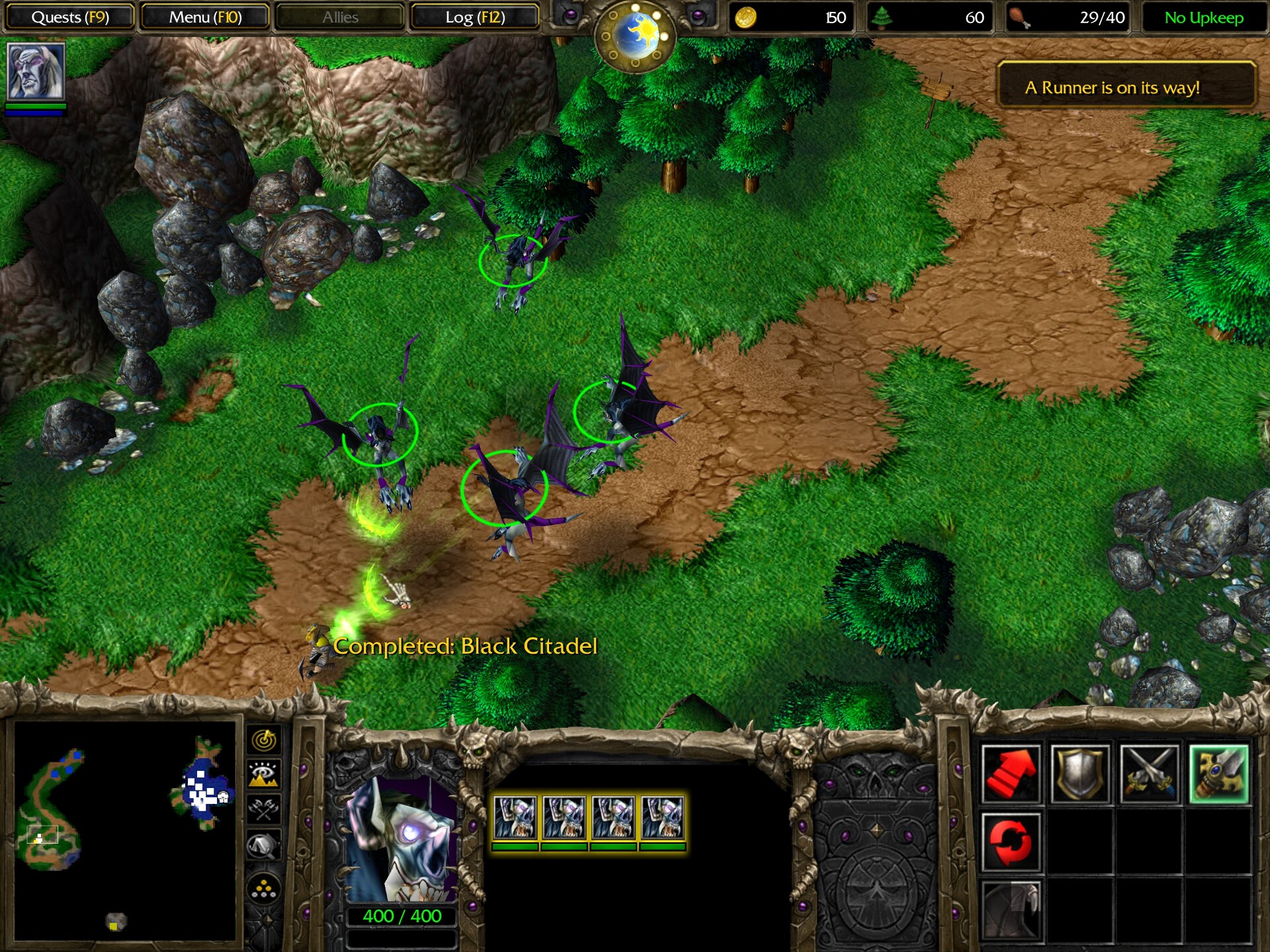
Gargoyles are light and fast, and there aren’t any enemies on the possible routes runners can take, so stopping them isn’t hard as long as you aren’t distracted by something else. Still, it’s best to take out Sylvanas’s base as soon as possible before your gold mine runs out.
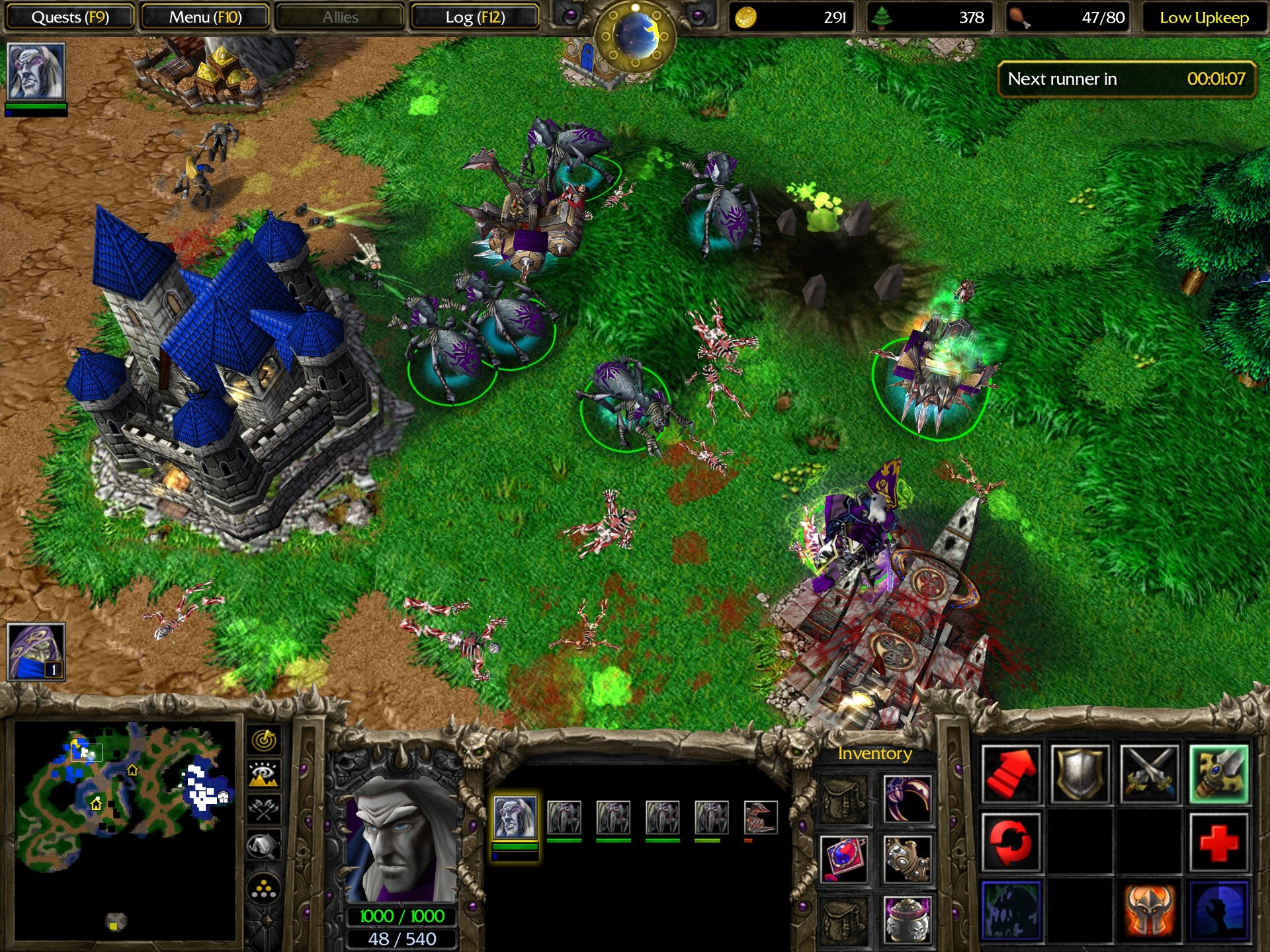
In this mission, Arthas gets his ultimate ability: Animate Dead. It picks corpses of the most powerful six units in the vicinity, whether allies or enemies, and raises them to fight for you for forty seconds. Best of all, they’re invulnerable until they expire, and they can be targeted with Death Pact to heal the death knight without killing them.1 Bizarrely, in the original and very iconic Russian translation of Warcraft 32, Animate Dead was named “Galvanization”. A reference to making corpses twitch with electric current, perhaps?
Once Sylvanas’s base falls, Arthas mortally wounds her in a cutscene. She begs for a clean death, but after everything she’s put him through, Arthas isn’t quite willing to oblige. Instead, he gruesomely draws out her soul, turning her into into a banshee.
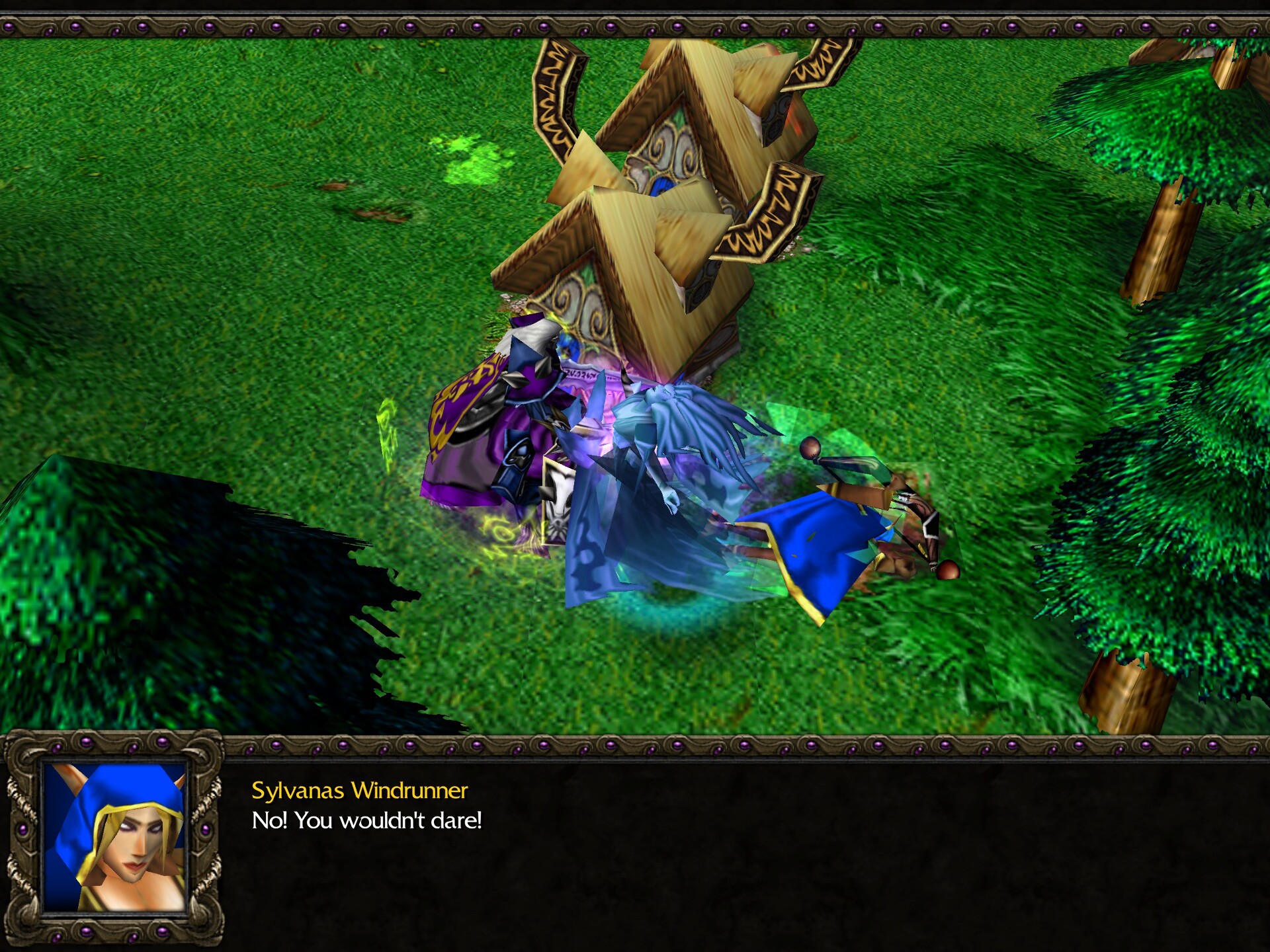
Weirdly, this is where Sylvanas’s involvement in the Reign of Chaos storyline ends entirely. You get her as a unique banshee unit — a regular unit you can lose, not even a hero — and she doesn’t appear at all in any subsequent missions.
At this point you also unlock the regular banshee unit. Banshees are all-female ghosts of slain elves who make it very clear that they’re fighting for you against their will, with tortured cries like “You brought me back?!”, “If I must” and “I must obey”. They start as debuffers, cursing enemies to a 33% miss chance, but their most iconic ability is Possession, which sacrifices the banshee to permanently take control of an enemy unit.
Now it’s time to turn towards Silvermoon. I attacked from the western side because it was closer, which turned out to not be optimal, because as soon as the city got alerted, they sent a (generic human) archmage against my relatively lightly defended base. As I was building banshees at the base at that time, I turned their own swordsmen and archers against them, which felt satisfying in an evil bastard kind of way.
While Silvermoon has two bases, one on the west and one in the east, they don’t pose that much of a threat compared to Sylvanas, and destroying Silvermoon isn’t your objective anyway — securing the Sunwell is. So you have a lot of options for this part of the mission, and correspondingly a lot of replay value. For example, while the game doesn’t tell you this, you can possess an elven peasant (who, hilariously, has the voice lines of a human peasant) and build up their entire technology tree.
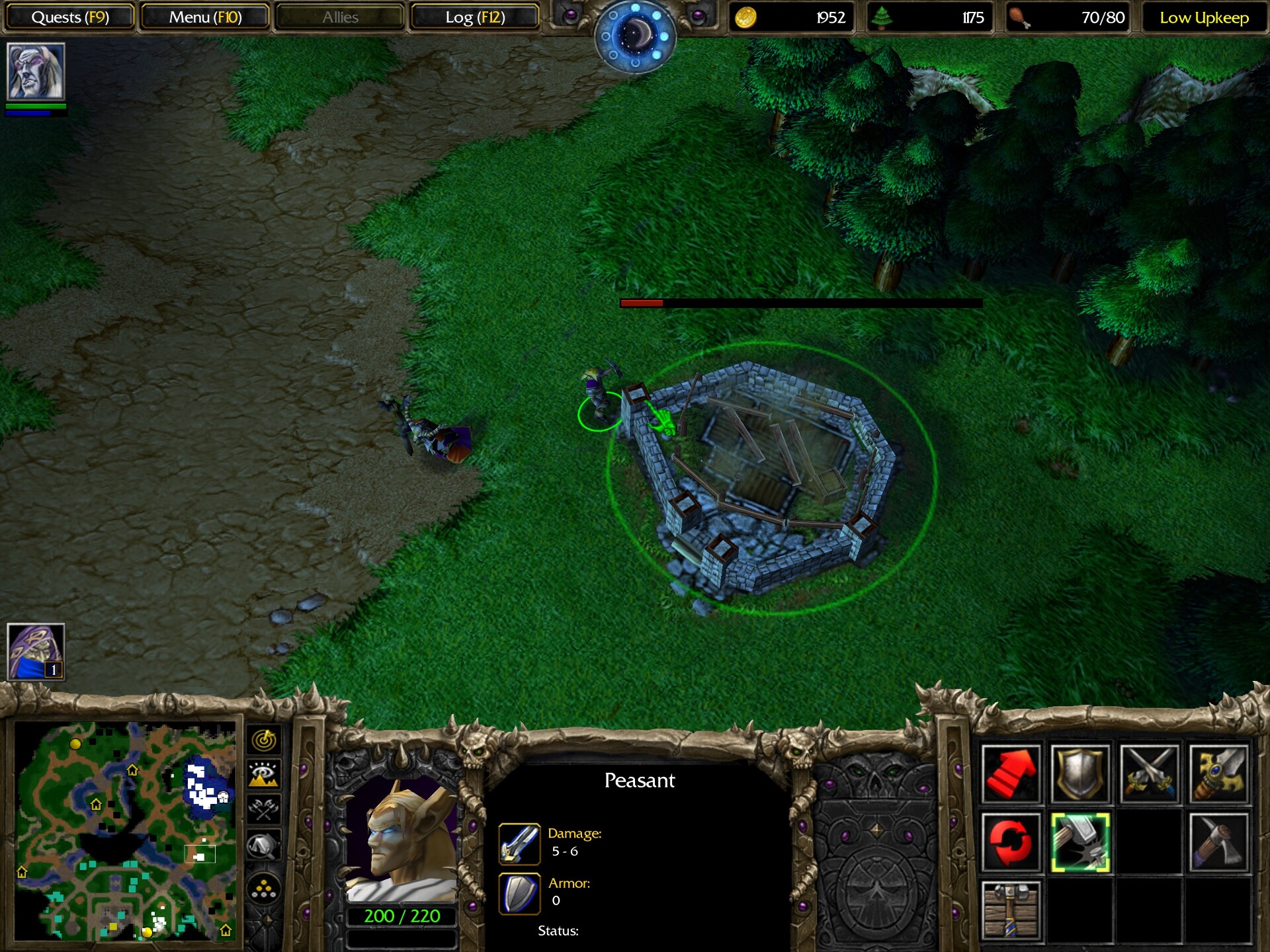
The Sunwell itself is protected by towers and… rock golems?
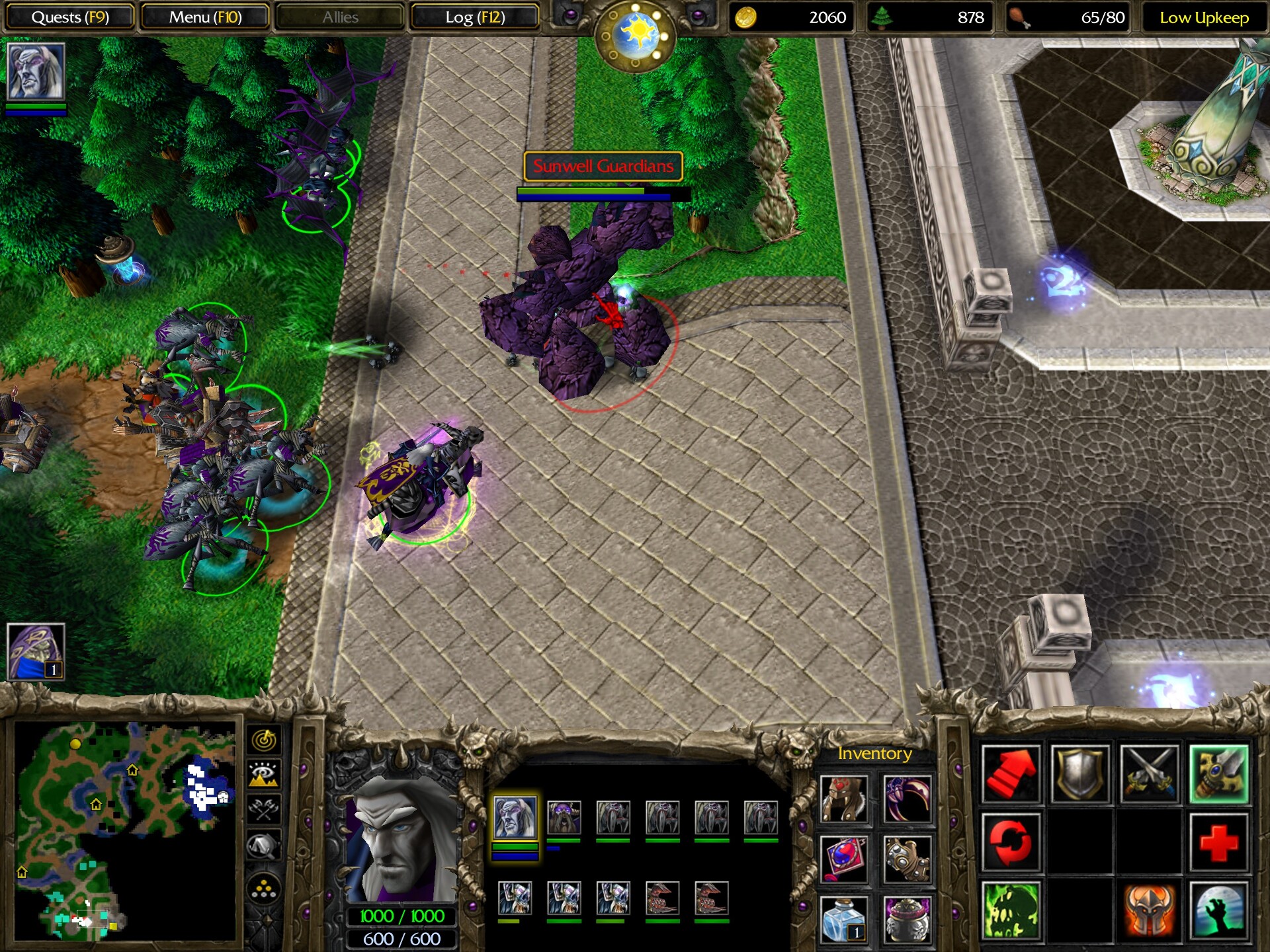
The Quel’Thalas missions seem kind of phoned in, to the point that I wonder if they were an afterthought to pad out the campaign. Not only do they drag out without much plot happening, but the high elves reuse a lot of human assets, some cut Alliance units3, and the only named character is Sylvanas, who isn’t seen or even mentioned anywhere in the rest of the campaign. Once you defeat her, you face no more named elves until the end of the mission.
Another interesting thing to note is that while the manual and loading screen maps place the Sunwell across a strait from Quel’Thalas, in the actual mission it’s located in Silvermoon, right at the center of it. It makes sense, considering the previous mission established beyond all doubt that Arthas has no means of crossing water on his own. So if some hypothetical remake of Warcraft 3 made the mission map more WoW-lore-accurate, I’d expect them to remember the plot point introduced just a mission ago–
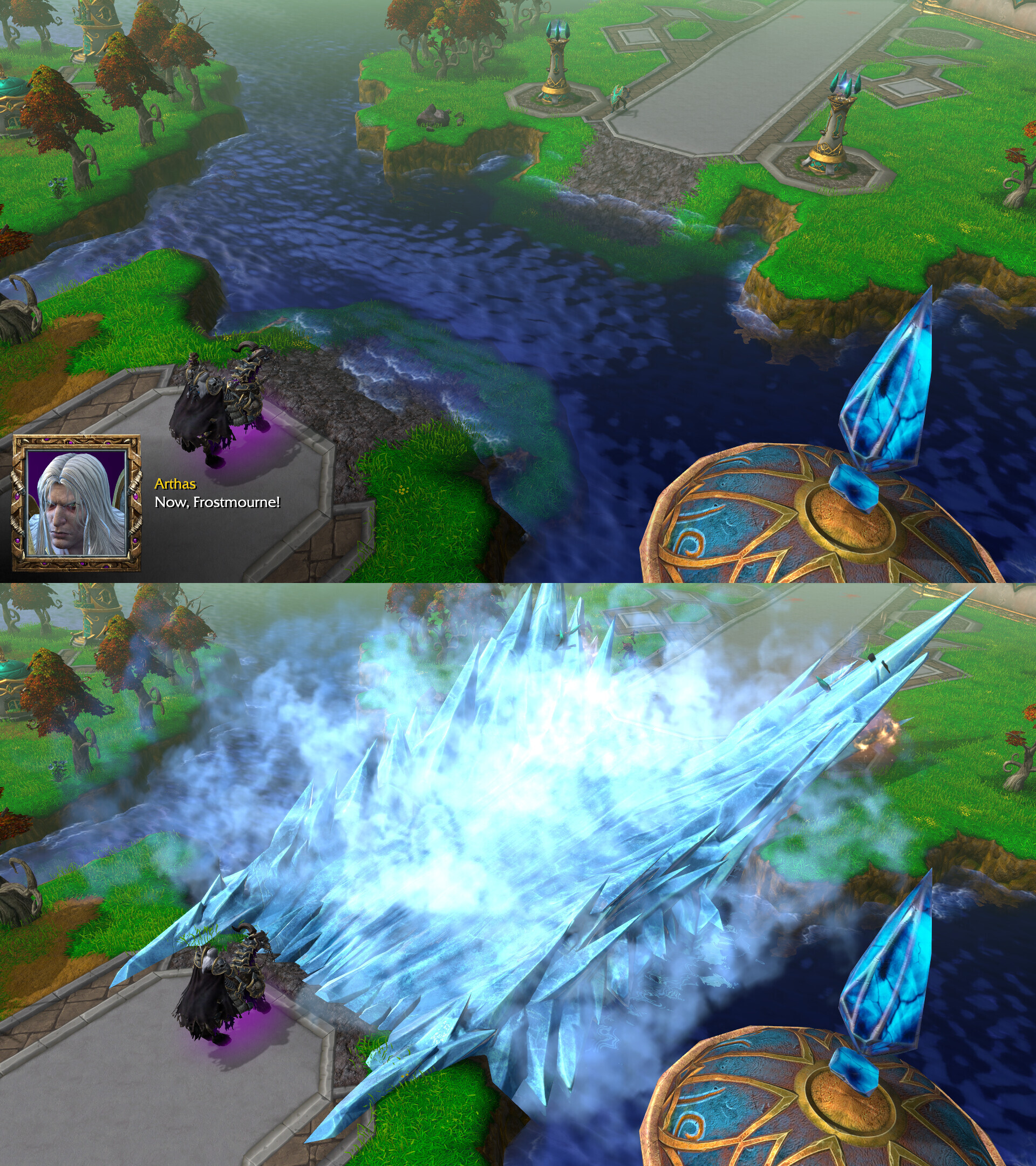
Sigh. Reforged completely revamped this mission to fit WoW geography and aesthetics, but in the process, introduced not one, but two plot holes. We’ll talk about it in due time. For now, I’ll just have to accept that Arthas somehow got unexplained ice powers between missions that take place mere moments apart–
…Fine, fine, I’ll let it go.
In the original, the Sunwell just reuses a generic fountain model. Arthas announces the end of Quel’Thalas for their stubborn resistance, then Kel’Thuzad basks in the Sunwell’s golden glow, tainting in in the process, and is reborn as a lich.
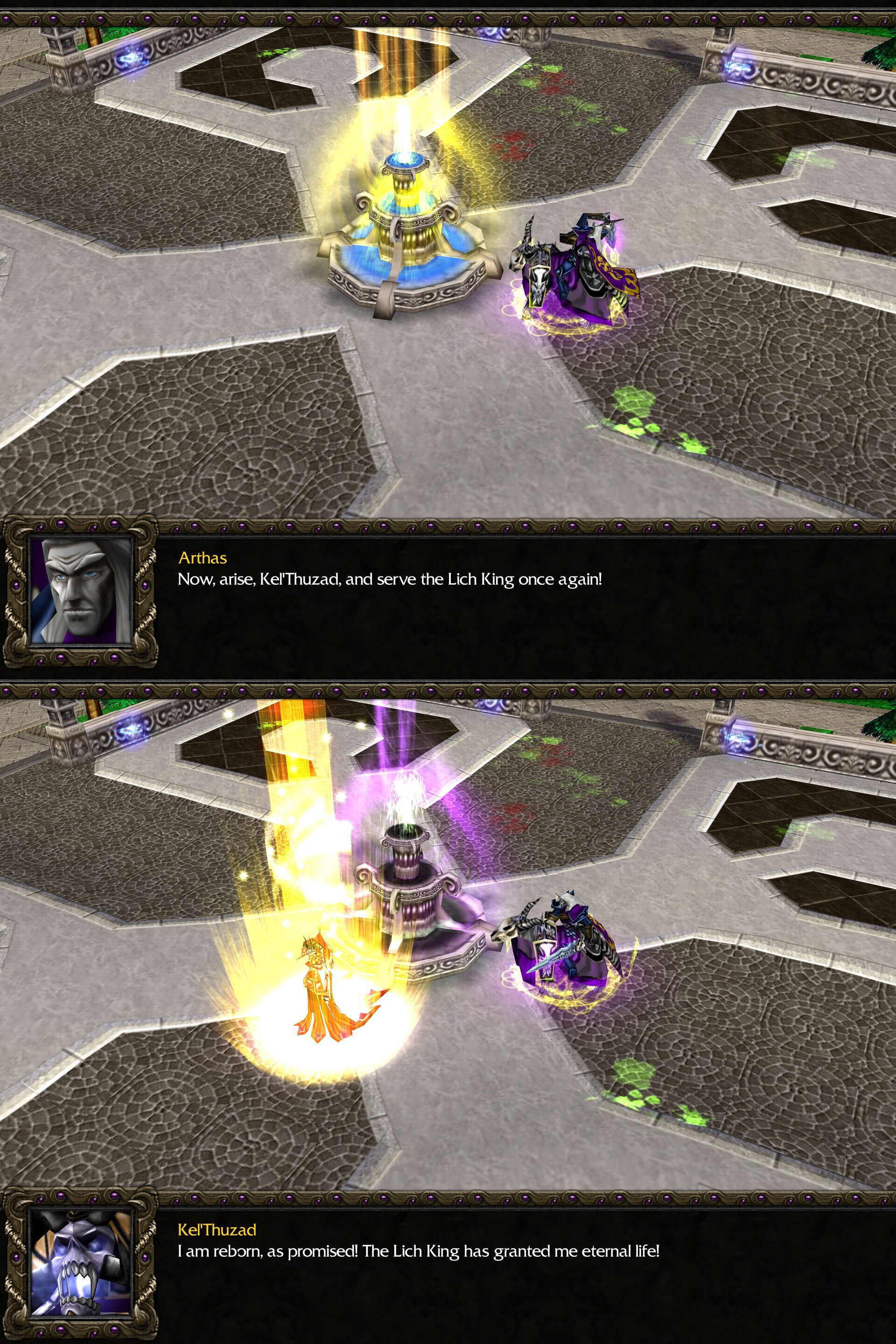
Now Arthas asks Kel’Thuzad to uphold his end of the bargain and tell him about the dreadlords. And he will — but not here.
The Revelation
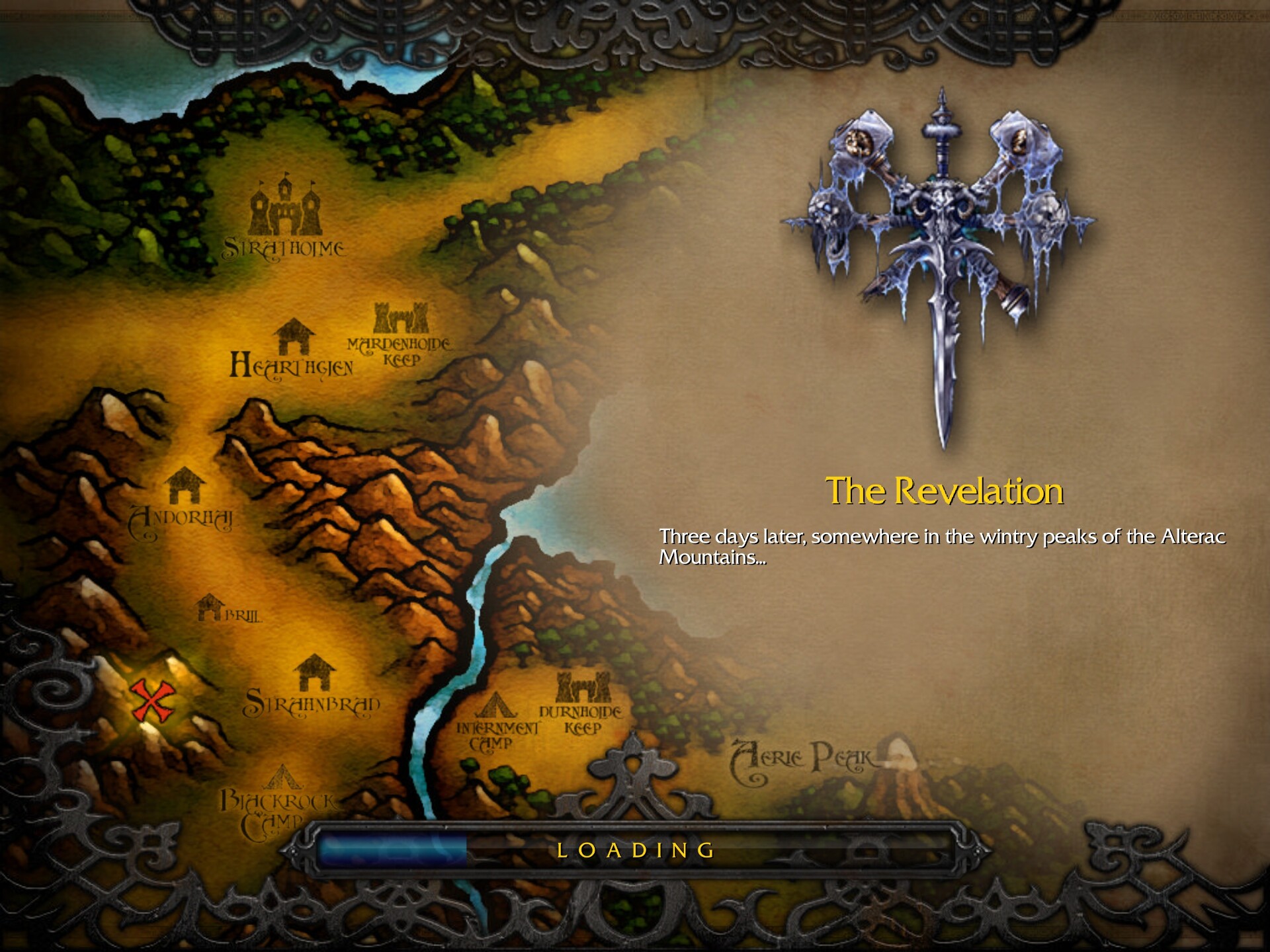
While our heroes (for a given definition of “hero”) were busy turning Quel’Thalas into a wasteland, winter came to Lordaeron. In a mountain pass in Alterac, Kel’Thuzad reveals that the Lich King foresaw Arthas killing him, and actually selected the prince as his champion before the Scourge even began. As for the dreadlords…
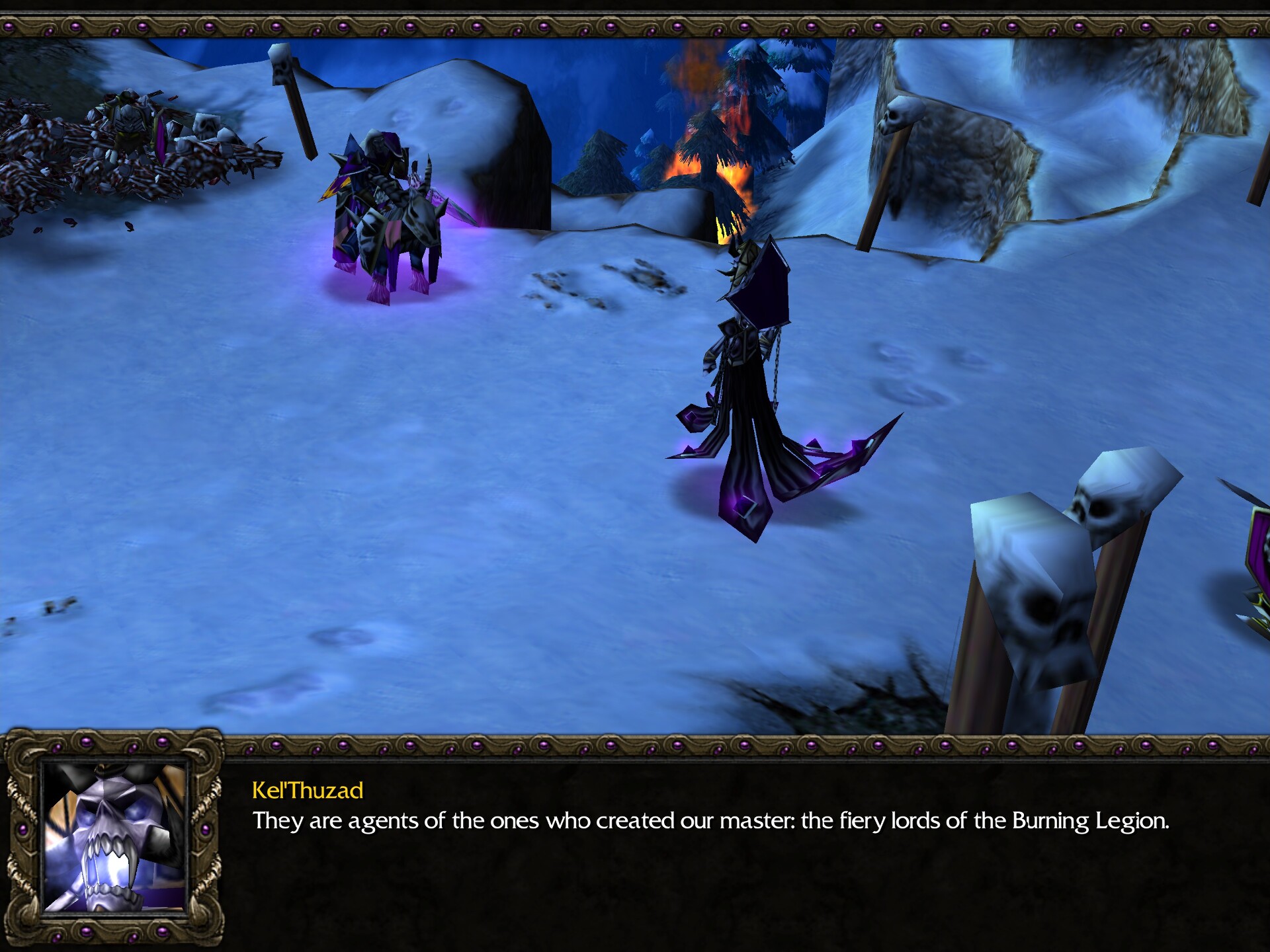
And we’re actually shown the Burning Legion!
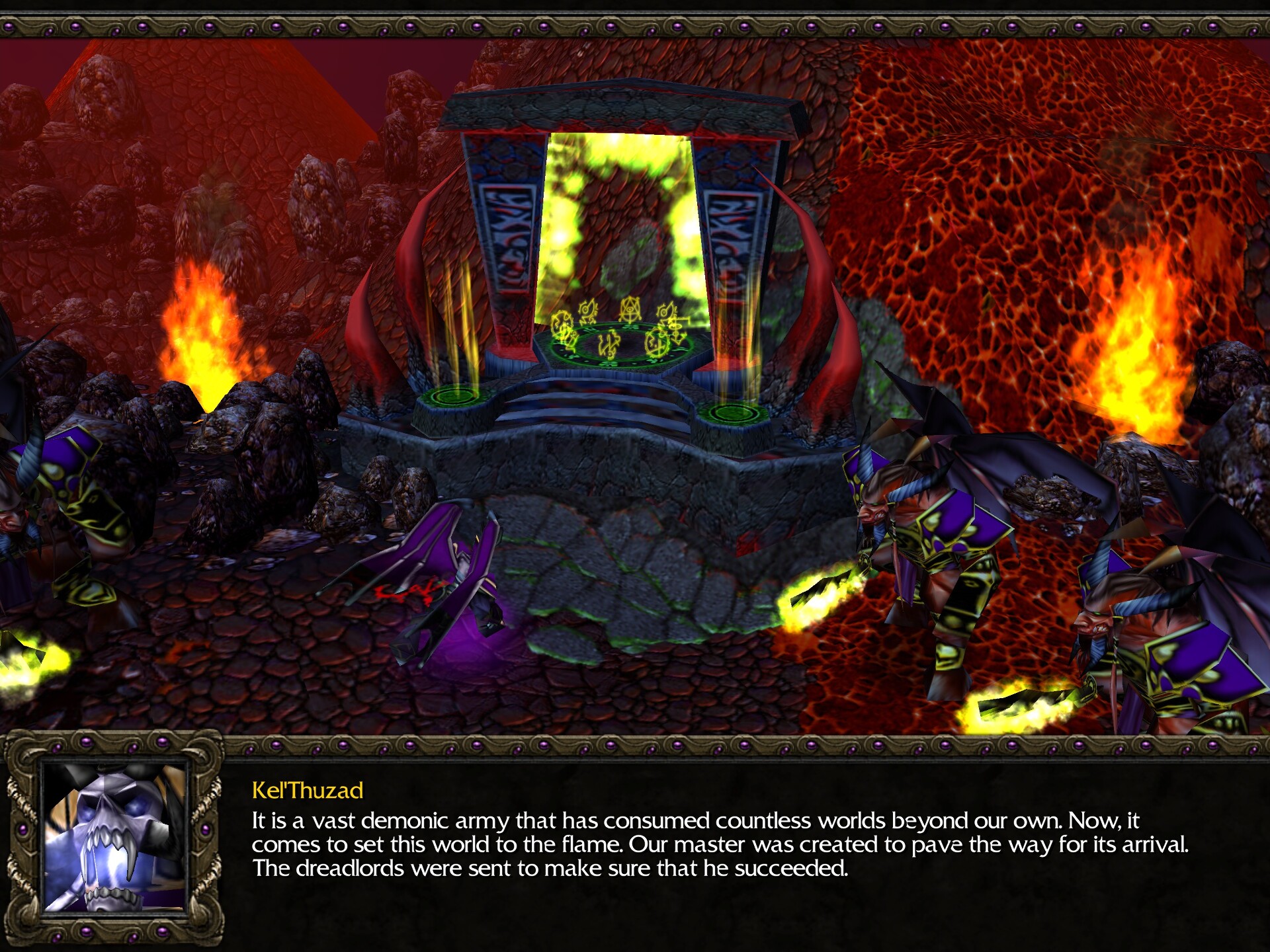
The plague in Lordaeron and the sacking of Quel’Thalas were just the prelude to a demonic invasion. The Legion used the Scourge to soften the world’s defenses, eradicating the forces that could resist their arrival. Now it’s the time to move to the next stage of the plan: summoning the demon lord who will actually lead the invasion.
Blackrock & Roll, Too!
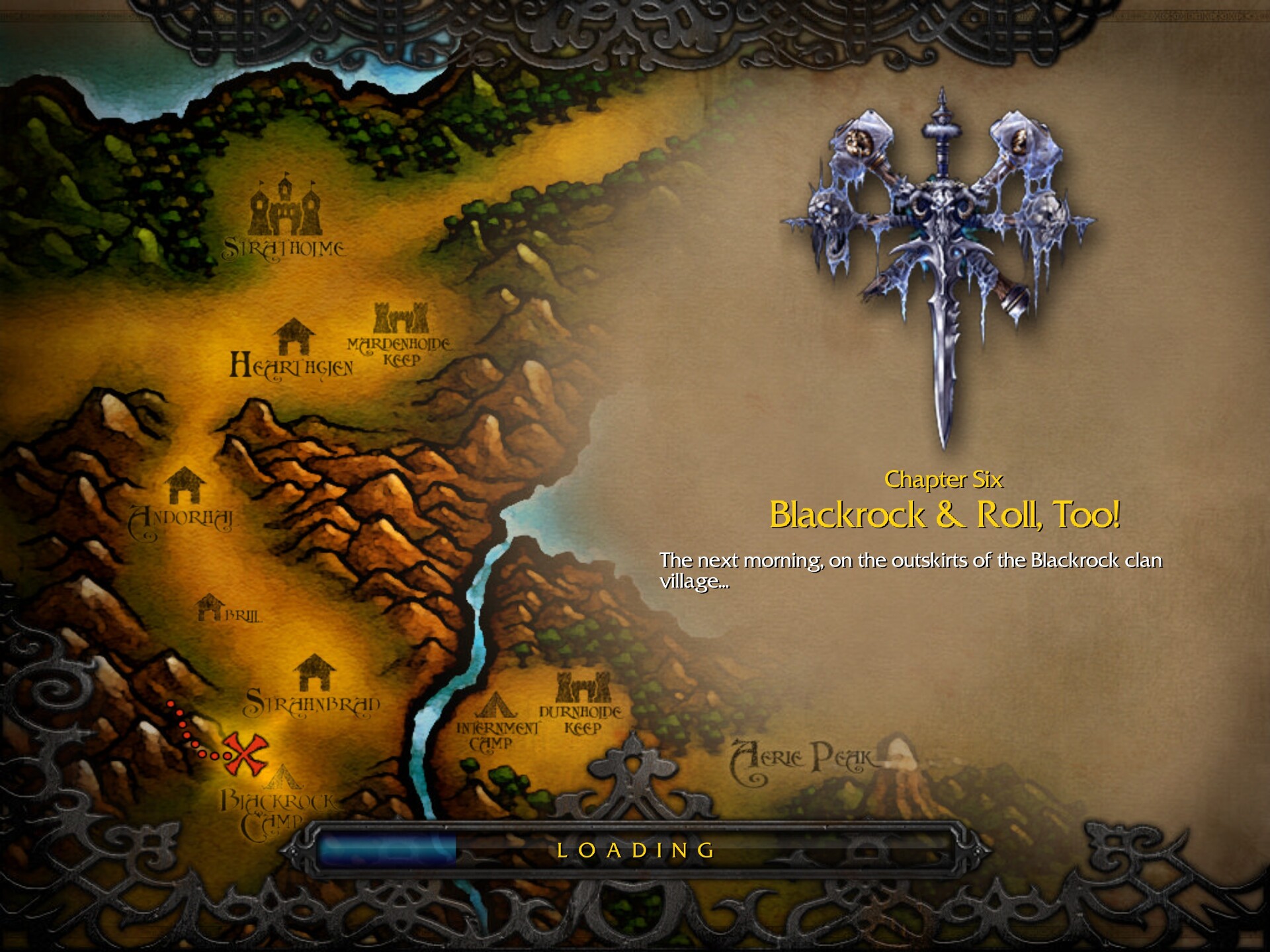
The good news is that there’s a demon gate nearby that will do exactly what Kel’Thuzad needs: let him communicate with the demon lord to receive further instructions. The bad news is that it’s protected by a bazillion Blackrock orcs.
Despite appearances — you get surrounded by five orc bases — this mission is actually not hard. You’ll just take out the bases in order. There are two factors that take the stress off you. First, you get a second hero, Kel’Thuzad the lich; and second, this mission gives you frost wyrms, powerful undead dragons that are absolute monsters of a unit. While frost wyrms are slow to build and cost whopping seven supply, more than any other unit in the game, they have a splash slowing attack and, with a researchable upgrade, can freeze enemy buildings, halting their attacks and production, which makes base sieges a breeze.
…Get it? A breeze! …What?
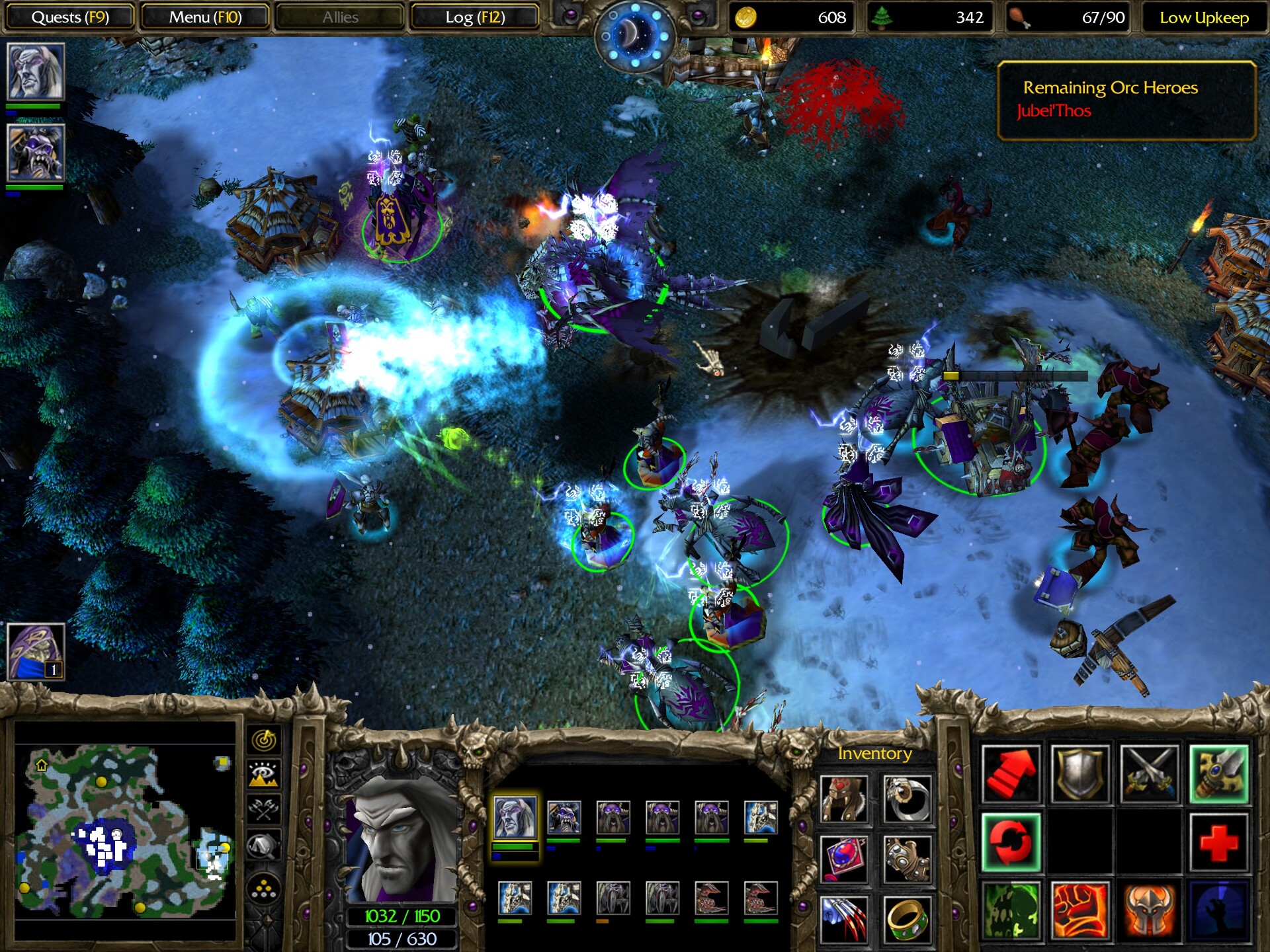
They also have a decent anti-air attack, which is good because enemy air units have been a pain so far, forcing me to rely on crypt finds to bring them to the ground, and these orcs have big, powerful red dragons.
While your objective is just the red player, it’s better to take them all out, since every slain orc hero drops a stat-boosting tome. In theory, you can distribute them between your two heroes, but in practice, as we’ll soon see, it’s best to give the power-ups to Arthas alone.
Gameplay-wise, this mission is fun and it’s satisfying to see the orc bases fall to you one by one. Story-wise, however, it’s chock full of continuity issues.
- Kel’Thuzad uses a generic lich model. While this look has since become iconic and very much associated with Kel’Thuzad, it doesn’t explain why an undead human has an orc-like skull. (Generic liches, as said in the manual, are Ner’zhul’s orc followers raised into undeath, so the model makes sense for them.) It’s pretty clear that the model came first and the character second, which makes me wonder if Kel’Thuzad wasn’t in the original script4 and instead the primary lich hero was supposed to be Ner’zhul or one of his lieutenants.
- The Blackrock orcs use red dragons, even though Alexstrasza has long been freed by this point, all the way back in Day of the Dragon.
- They have jungle troll headhunters, who weren’t part of the old Horde and only allied themselves with Thrall later during his voyage to Kalimdor. Reforged replaced them with forest troll axethrowers, which is more fitting.
- Their heroes are blademasters, which makes sense, and far seers, which doesn’t. Far seers are a type of shaman, like Thrall. These demon-worshiping orcs don’t have the regular shaman unit, instead using the campaign-only warlock unit, and logically they shouldn’t have far seers, either. In Reforged, the far seer heroes have warlock models… and still use shamanistic powers. You were so close to getting it right, Reforged. So close.
- Finally, are you really telling me that there were this many demon-worshiping orcs living in the Alterac Mountains all this time, and yet their existence was completely unnoticed by both Lordaeron and the nearby Frostwolf clan?
That last point deserves particular emphasis. All the way in the first entry, I said that my goal was to examine the cracks in Warcraft’s foundations. Here, we see a plot element that’s relatively harmless on its own, taking Warcraft 3 in isolation, but becomes more and more damaging to the believability of the setting as it gets repeatedly reused in the sequels.
In Beyond the Dark Portal, we were told that the clans of Doomhammer’s Horde were captured and put into internment camps. In Lord of the Clans, we learned that the Frostwolf and Warsong clans stayed free all along, one hidden and the other evading capture. Now we have another clan of free orcs that was previously unaccounted for. And later, World of Warcraft will retroactively add so many independent clans to the eastern continent that sometimes it feels like Thrall was the only orc who was ever imprisoned.
It’s important to realize that plot holes are a gradient. As long as they don’t significantly distract from the story, they can pass by unnoticed. We’ll later talk about why Warcraft 3, despite some flaws in its storyline, still holds well together and is rightfully remembered as a beloved classic.
Anyway, we secure the demon gate. The Scourge mops up the orcs, who have outlived their usefulness to the Legion, and Kel’Thuzad receives his next instructions from Lord Archimonde.

The spellbook in question is kept in Dalaran, and, of course, the Kirin Tor won’t surrender it willingly.
The Siege of Dalaran
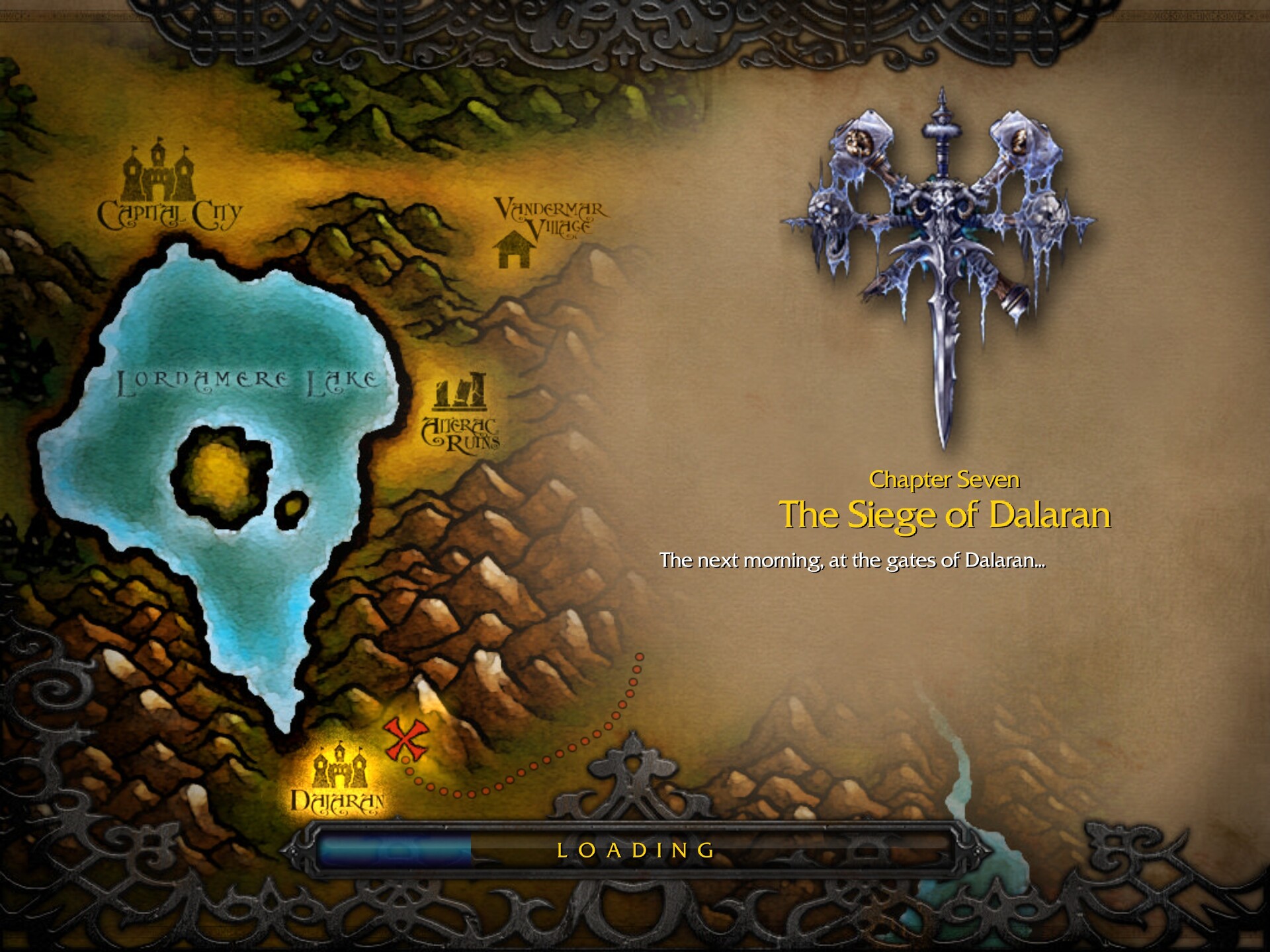
Arthas arrives at the gates of Dalaran, demanding that the wizards of the Kirin Tor surrender to the Scourge. Antonidas replies… with snark.
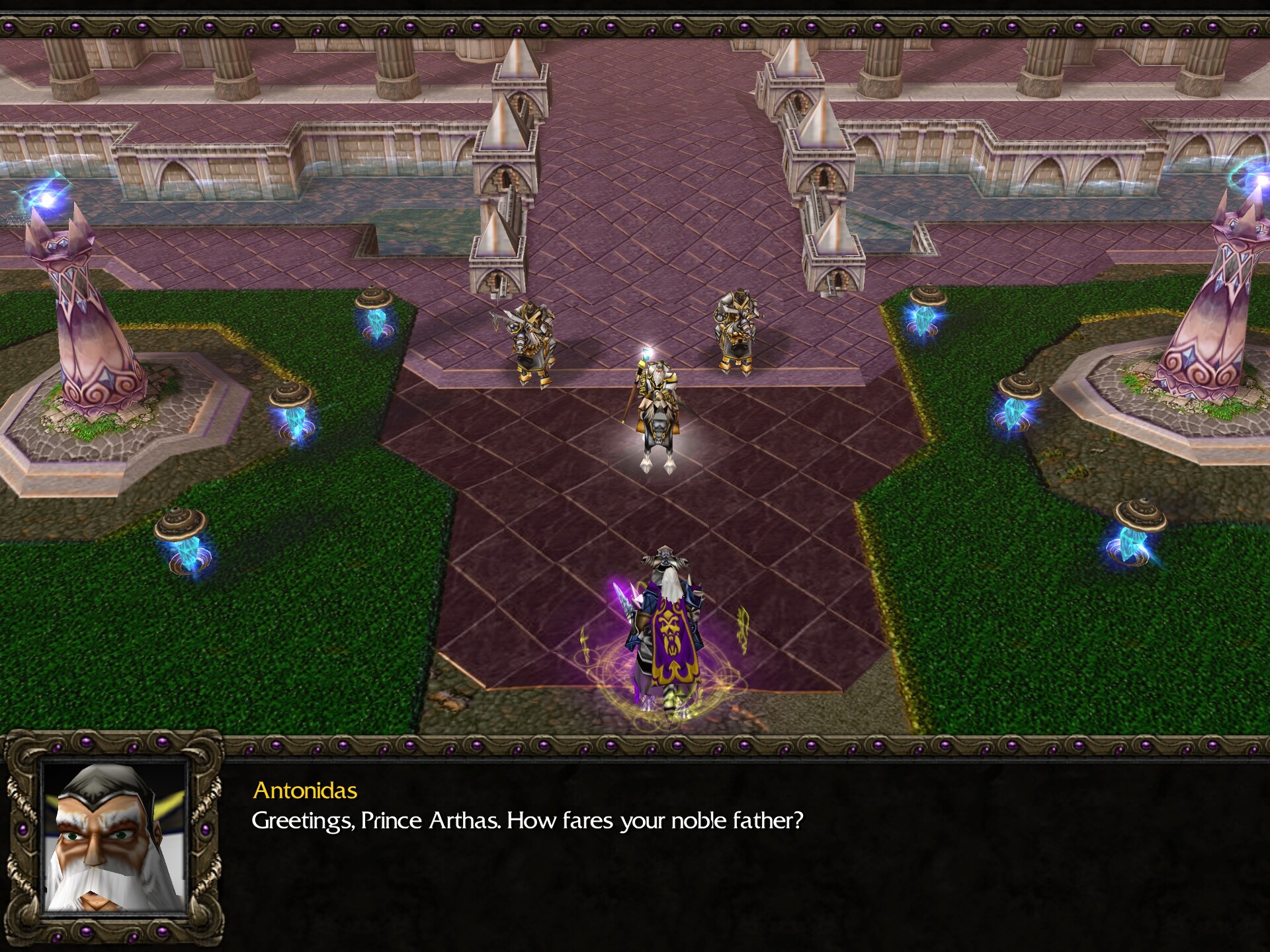
Antonidas boasts that the mages have prepared for Arthas’s arrival by erecting magical auras that will destroy any undead that pass through. Then he teleports away.
The aura indeed makes it unviable to rely on the undead faction’s primary tactic — spamming waves of individually weak units. Thankfully, at the start of this mission, you unlock abominations — bulky and sturdy flesh golems. Frost wyrms work well too, but will take some time to be ready.
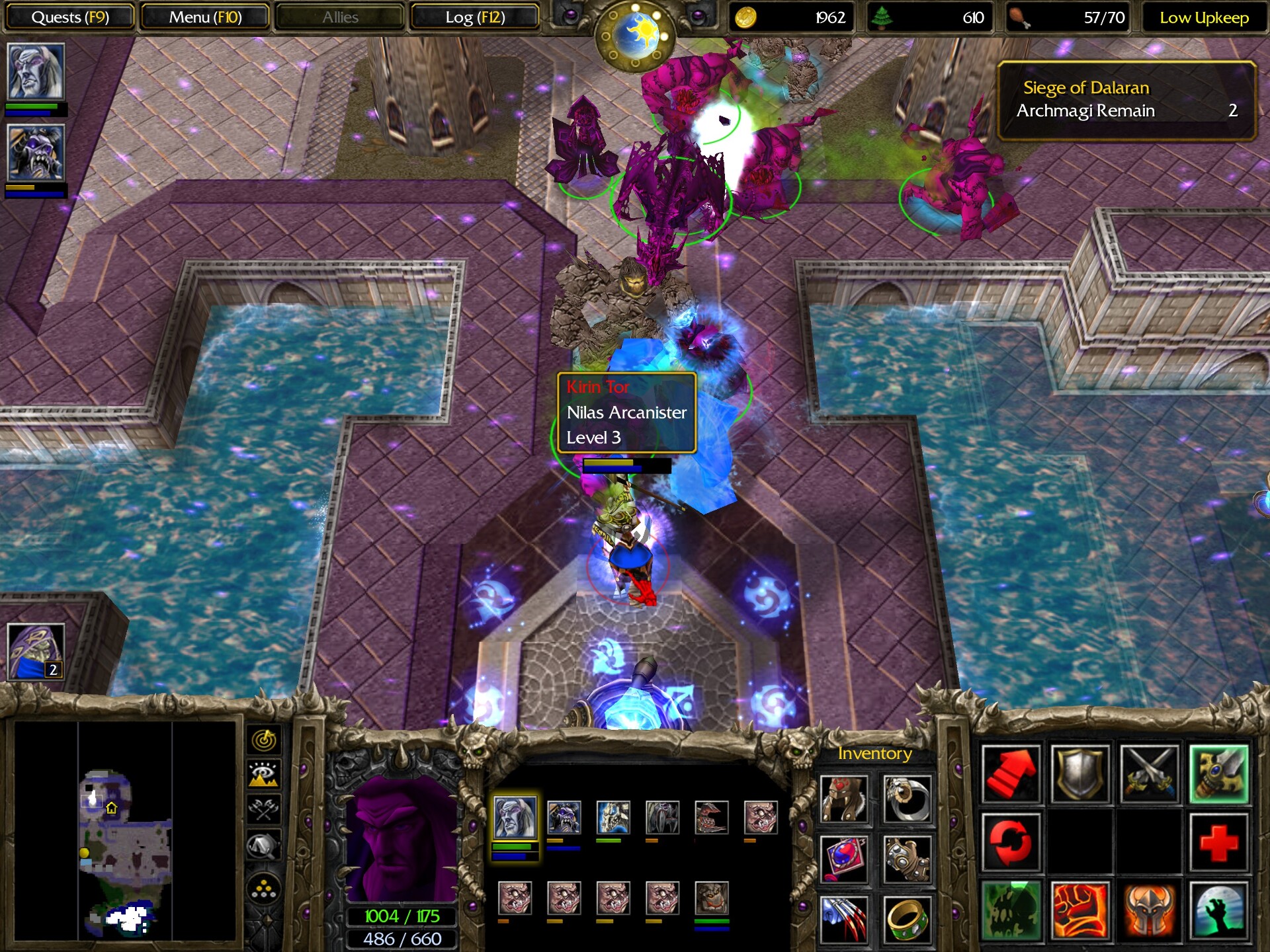
This mission is pretty easy — a nice breather level between the rather involved previous two chapters and the absolutely brutal final one. You advance through Dalaran at your leisure across a narrow map. There are three archmage heroes maintaining the aura, and after you kill the first two, their auras dissipate, allowing you to advance. There are some helpful treasures along the way, like storage crates containing rock golems that are immune to the undead-damaging aura. Even Antonidas himself, for all his buildup, is kind of a pushover, as you can ignore his entourage and summons and just shoot him with a maxed-out Death Coil or two.
Reforged completely overhauled this mission and, amazingly, did it right. The wizards feel like more of a threat, there are secrets to uncover that give a good look at Kirin Tor culture and their fondness for hoarding knowledge and conducting weird magical experiments, and Antonidas was upgraded to a proper climactic boss fight. It’s a glimpse of what Reforged could have been — a total overhaul and modernization of the campaign — if not for its troubled development and inept management.
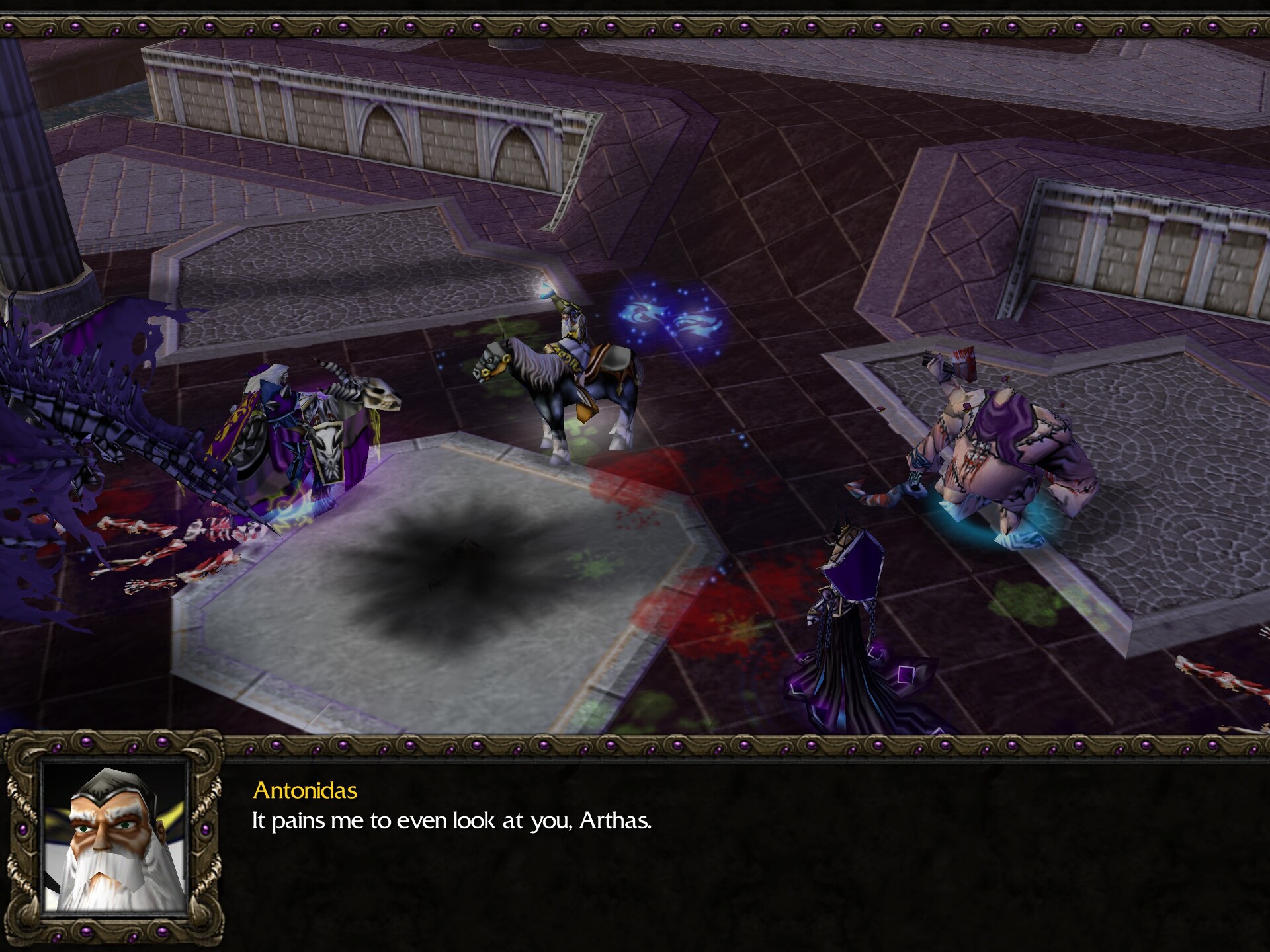
Antonidas dies, Dalaran is in ruins, and the spellbook is ours. It’s time to proceed to the summoning ritual that will bring Archimonde into the world.
Under the Burning Sky
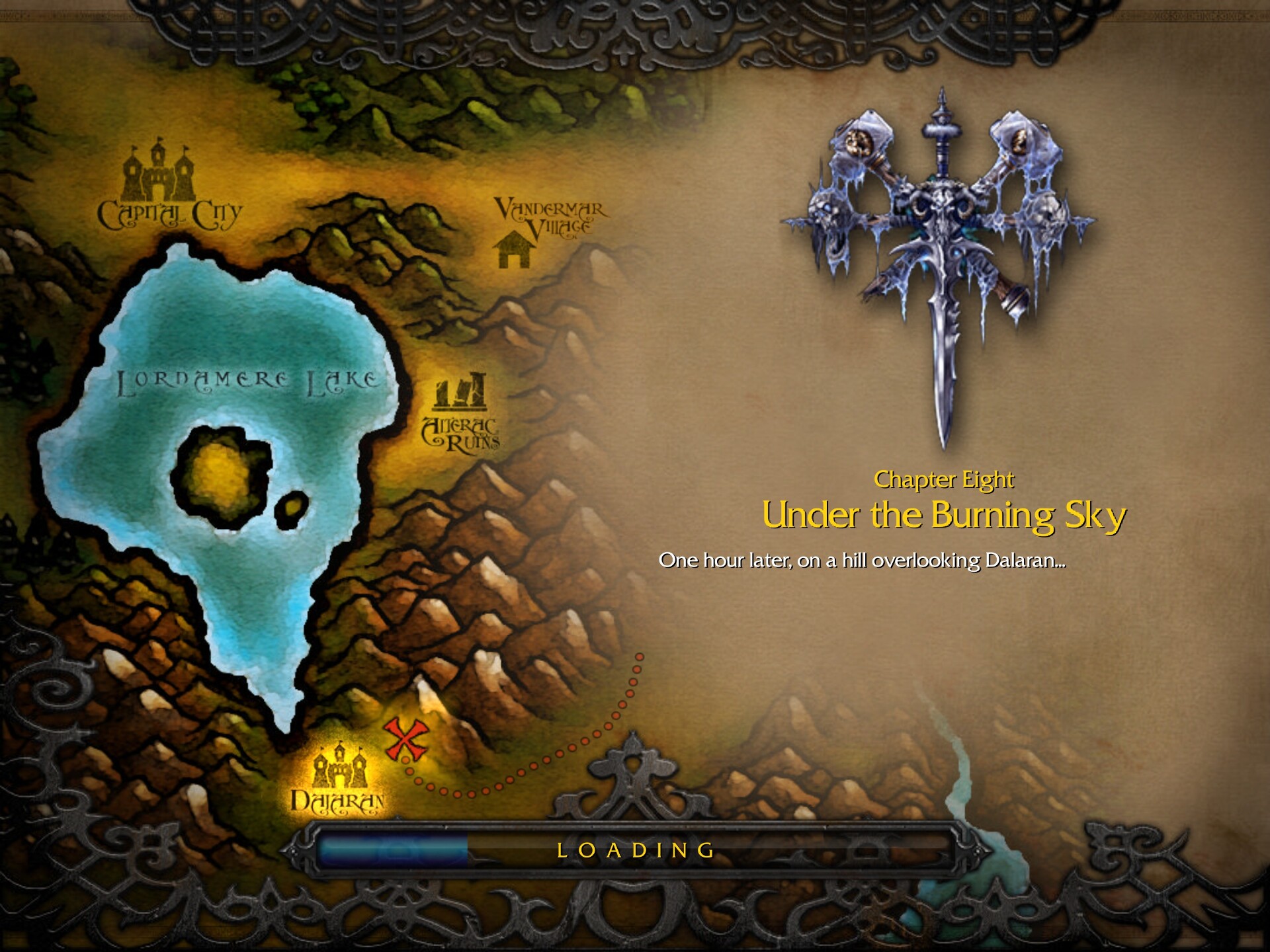
Apparently one hour was all it took for Kel’Thuzad to read through Medivh’s spellbook and get an understanding of the ritual.
This is a hold-the-line mission, and it’s damn hard. The humans are moving in from three massively-fortified bases, hell-bent on stopping the summoning ritual. Meanwhile, we’re back to controlling one hero, stuck protecting a squishy lich whose death results in an instant game over.
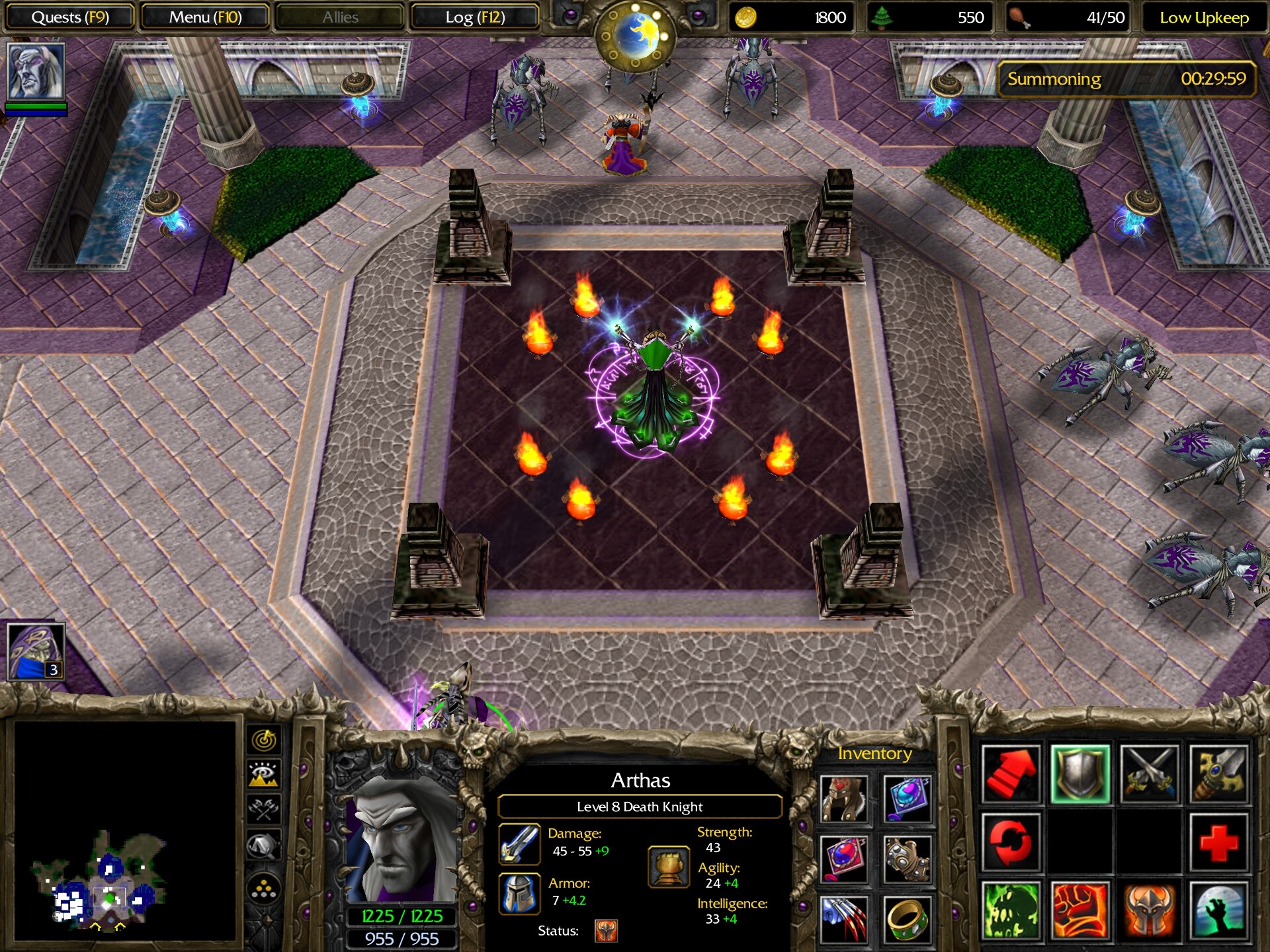
On hard difficulty, this is probably the hardest mission in Reign of Chaos. Even on normal, it kept me on my toes, with a lot of my time spent frantically repairing and rebuilding my towers after enemy steam tanks plowed through them like a knife through butter. The Burning Legion does send reinforcements — two packs of felhounds and then infernals — but at the last minute the assault becomes brutal, with the humans sending massive waves from all three directions. Worse yet, your gold mine doesn’t have enough gold to last through the entire mission. Thankfully, my expansion survived intact until the very end.
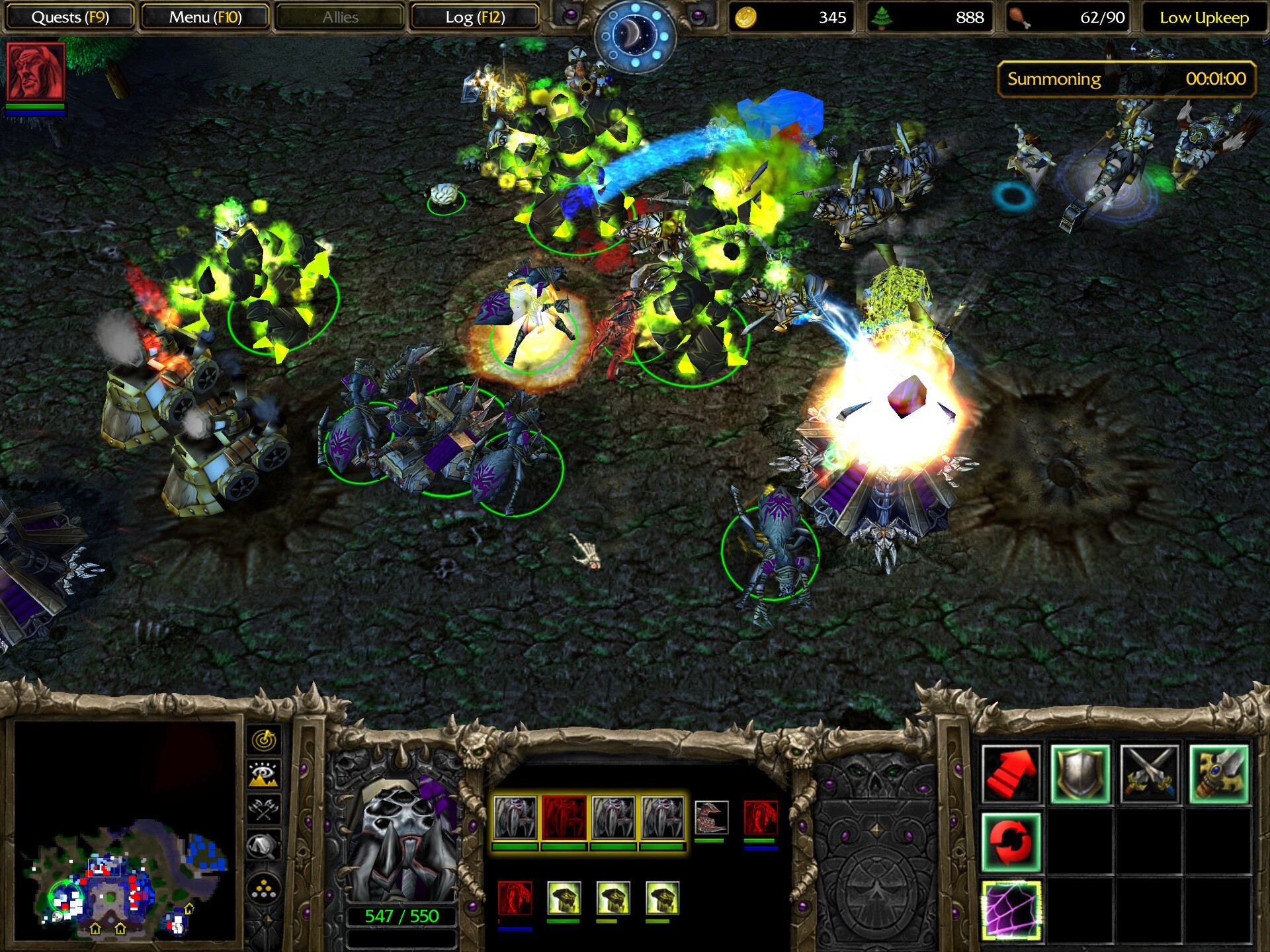
After the enemy razed my towers, they beelined straight for Kel’Thuzad, whom I was able to keep alive with two Death Coils, long enough to outlast the timer.
Archimonde makes an absolutely glorious entrance.
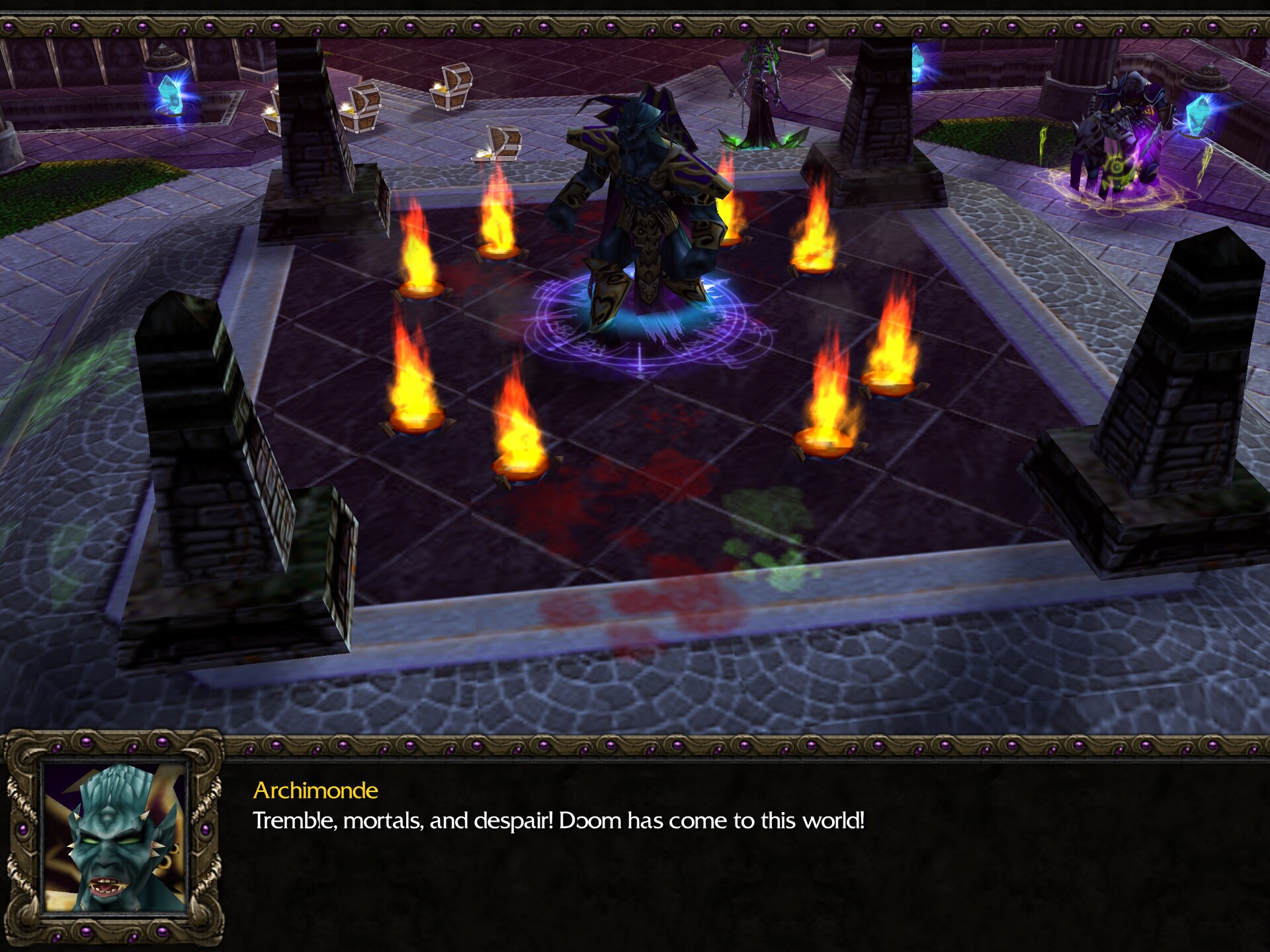
Now, the Burning Legion’s invasion begins properly. As the Lich King is of no further use to Archimonde, he reassigns command of the Scourge to the dreadlords. To say this makes Arthas livid would be an understatement, but Kel’Thuzad urges patience. The Lich King foresaw this as well, and Arthas still has a role to play in his ultimate plan. For now, the two will lay low.
As for Archimonde, he doesn’t toy around and lets his power immediately be felt. In his character-establishing moment, he effortlessly levels Dalaran by conjuring and then knocking over a sand effigy of the city.
This is how you establish a cosmic, power-level-through-the-roof villain. Not by making boastful grandiose speeches that make him look like an edgy tryhard. Not by making menacing gestures at a random schmuck who escapes his allegedly inescapable prison within ten minutes of learning of its existence. But by making it clear that he means business, that we puny mortals are mere ants to him, and that he has no need to lower himself to facing us in combat when he can destroy whole cities with a wave of his hand.
Be afraid. Be very afraid.
Mid-Campaign Thoughts
Personally, I think the undead campaign is the weakest of the four. It doesn’t mean it’s bad per se — Warcraft 3 stays strong all throughout — but rather that it’s merely good while the other campaigns are great.
Part of it is that it seems we’re retreading the story beats of Starcraft. Following the fall of the human capital (Lordaeron/Tarsonis) to an unrelenting swarm that turns everything into more of itself (undead/zerg), we now play as the bad guys where the recently corrupted human hero (Arthas/Kerrigan) is, for now, but a pawn of the true leader (Archimonde/Overmind), but is yearning for independence. A lot of the campaign is spent on exposition and setup for later payoff.
The pacing issue I’ve already mentioned. This campaign starts slow in the first half, but in the second, it really picks up and we go through the fall of Silvermoon, the remnants of the Warcraft 2 Horde, and finally Dalaran, in very short order, leading to a very tense and satisfying climax that really makes you feel the world is doomed. The campaign also, to its credit, avoids the “evil is one big happy family” cliche, establishing mutual distrust and contempt between the Legion and the Lich King that will become important later.
Here’s another question to ponder. So the Legion wants to invade Azeroth in full force. To do this, they need Kel’Thuzad to summon Archimonde. Kel’Thuzad serves the Lich King and has no love for the Legion. So can he just… not summon Archimonde? What’s stopping the Scourge, at this point, from betraying the Legion and offing the dreadlords to free the Lich King from their influence? Is it because there are dreadlords in Northrend holding the Lich King’s undead body hostage to make sure he doesn’t try exactly that? It would be nice if the game explained this.
Still.
Even the slowest-paced missions of Warcraft 3 are still dynamic and don’t kill the tension. And it does make sure to properly set up the world, introduce all the relevant characters, and invest in foreshadowing, hanging all the Chekhov’s guns that will be firing later. And Kel’Thuzad and Arthas here have an affable master-and-apprentice kind of relationship.
And the Scourge establishes itself as a real threat by upping the ante from Warcraft 2, succeeding where Doomhammer failed. Whereas the Second War Horde, lore-wise, failed to capture Dalaran, Silvermoon and Capital City, here, the Scourge crushes all three. The once-proud Alliance now lies in ruins, and now, the fate of the world itself is at stake.
For now, we’ll take a break from doom and gloom and wanton destruction, as we return to Thrall and the Horde and find out what they’ve been up to in the meantime, on the other side of the world. Next up: the orc campaign!
-
This isn’t how the ability worked at release, though. It used to raise the dead for 120 seconds without invulnerability, making Animate Dead basically a worse version of the paladin’s Resurrection. ↩
-
Which was outsourced to a Russian company that took a lot of creative liberties. Blizzard later made a Russian translation of WoW in-house, translating the terminology and names closer to the original, and all subsequent Warcraft games used these new translations consistently. Reforged was redubbed, too. ↩
-
Including the dragonhawk, which later got reused for the expansion. ↩
-
We know that the Warcraft 3 script underwent lots and lots of rewrites. For example, originally it was Jaina who was supposed to be raised as a banshee, not Sylvanas. It was changed because it felt too reminiscent of Raynor and Kerrigan. ↩
Leave a Comment